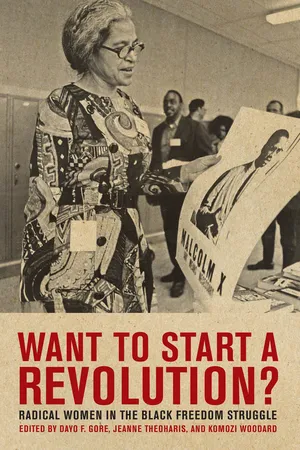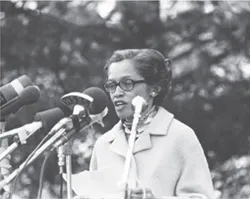![]()
1
“No Small Amount of Change Could Do”
Esther Cooper Jackson and the Making of a Black Left Feminist
Erik S. McDuffie
On April 18, 1942, a twenty-three-year-old African American woman named Esther Cooper delivered the opening address of the Fifth All-Southern Negro Youth Conference held on the campus of historically black Tuskegee Institute in Tuskegee, Alabama.1 An activist trailblazer, she was the newly elected executive secretary of the gathering’s sponsoring organization: the Birmingham, Alabama-based Southern Negro Youth Congress (SNYC), a pioneering, World War II era civil rights group with links to the Communist Party, USA (CPUSA).2 Opening her speech by emphasizing black southern youth’s importance “to the resolute prosecution of the war for a speedy victory,” she called for a “Double Victory,” the defeat of fascism abroad and Jim Crow at home.3 She also called special attention to how the SNYC “recognize[d] the importance of [black] women in winning the war . . . for the preservation of democracy in the world.” Stating that black women were “an important part of the total woman labor supply needed in this crisis,” she argued that their inclusion in trade unions and extending social security and old-age benefits to domestic workers would be crucial for defeating Nazi Germany, Japan, and Italy.4
Her address embodied the CPUSA’s 1930s and 1940s era Popular Front agenda of racial and economic justice, antifascism, internationalism, anti-colonialism, women’s rights, and the protection of civil liberties. Her position as the SNYC’s titular head highlighted the ways in which Black Popular Front organizations of the 1940s provided black women with unique opportunities to hold formal, visible leadership positions. Above all, her speech illustrates one of the trademarks of her political activism that spanned the New Deal through the civil rights and Black Power era: her belief that black women’s status was the gauge for measuring democracy in the United States and across the world, and that progressives needed to foreground black women’s struggles in the left-wing agenda.5
Esther Cooper Jackson speaking in 1968 in Great Barrington, Massachusetts, at a ceremony in which the site of W. E. B. Du Bois’s childhood home was officially designated as a National Historic Landmark. Esther and James Jackson’s Personal Papers, Brooklyn, New York.
Until recently, the involvement of black women like Esther Cooper Jackson6 in the Communist Left and their connections to 1960s radicalism have received only cursory treatment from scholars interested in African American women’s history, black radicalism, and the twentieth century black freedom movement.7 Tracing her radicalization, enlistment in the CPUSA, and activism highlights the importance of the Popular Front as a site—albeit a contested one—for black feminist knowledge production and activism. Cooper Jackson—like other women drawn to the Communist Left during the 1930s and 1940s—formulated what literary scholar Mary Helen Washington has termed “black left feminism,” a distinct politics that combined Communist Party positions on race, gender, and class, and black nationalism with black women radicals’ own lived experiences that focused on working-class women. Paying special attention to the intersectional, transnational nature of black women’s multiple oppressions, black left feminists put forth gender liberation as inextricably connected to race and class liberation. In doing so, they attempted to recenter the Communist Left by arguing that African American working-class women’s concerns were central, not peripheral, to the socialist struggle.8
Cooper Jackson’s story also provides a lens for reassessing the impact of the Cold War on black movements and for reperiodizing postwar black feminism.9 Her work shows how black left feminism not only survived the politically repressive McCarthy era but also helped cultivate a new generation of black feminists in the 1960s and 1970s. This history, however, remains largely untold. Instead, much of the recent scholarship on 1960s and 1970s black feminism by Kimberly Springer, Benita Roth, and Premilla Nadasen either has focused on recovering black women’s involvement in “second-wave feminism” or has charted the ways in which black women fashioned their own distinct feminist politics during these years.10 For the most part, these works identify the civil rights movement, New Left, and Chicano/a movement as the “parent” movements to 1960s and 1970s black feminism. This scholarship also locates the emergence of black feminist groups such as the Third World Women’s Alliance and the Combahee River Collective as a counter to the infamous 1965 Moynihan Report and to the “resurgent masculinism of Black Liberation.”11 My intention here is to broaden these scholarly narratives by locating how black left feminism helped to lay the groundwork for 1960s and 1970s black feminism.12 In doing so, Cooper Jackson’s life and activism call into question the usefulness of the wave metaphor for understanding U.S. feminist struggles, which “neatly package[s] the women’s rights movement into peaks and troughs” and excludes women of color’s involvement in feminist struggles by “re-inscribing gender as the primary category of analysis that defines feminism.”13 Cooper Jackson’s work and legacy offer an alternative narrative to the wave metaphor, for her activism highlights both the breaks and the continuities in black feminist struggles from the 1930s through the 1980s.
This chapter begins with a discussion of Cooper Jackson’s formative years, illustrating how her family’s commitment to racial uplift was critical to her political awakening as a young woman. It then focuses on the impact of Popular Front movements on campus in radicalizing her. Next, the chapter examines her black left feminist stance embedded in her 1940 master’s thesis, “The Negro Woman Domestic Worker in Relation to Trade Unionism.”14 The story shifts to her leadership of the Southern Negro Youth Congress and how it served as an important site for black left feminism until Cold War repression crushed the group. The essay concludes with a discussion of her journalistic work in Freedomways: A Quarterly Review of the Negro Movement. The journal represented the continuation of black left feminism into the civil rights–Black Power era and served as an important but understudied site for the cultivation of a new generation of black feminists. Excavating Cooper Jackson’s life is important not simply because it tells a fascinating story of a remarkable activist and thinker but because her work has important implications for rethinking the origins, contours, and periodization of postwar black feminism, black radicalism, and U.S. women’s movements.
Early Years
Esther Cooper Jackson’s lifelong career as a radical activist was not inevitable. However, growing up in a politically conscious, talented-tenth black family committed to racial uplift prepared the ground for her life’s work and black left feminist sensibility. By the time she reached early adulthood, she was already well aware of racial inequality and her place in the world as a young African American woman.15
Esther Victoria Cooper Jackson was born on August 21, 1917, in Arlington, Virginia, to George Posia Cooper (1885–1937) and Esther Irving Cooper (1888–1970). Cooper Jackson was the second of the couple’s three daughters (Kathyrn, Esther, and Pauline). Her parents were part of the upwardly mobile group of black people who came of age during the so-called nadir of African American life.16 A strong, independent-minded woman, Irving Cooper was an educator, a community activist, and a major figure in the Arlington and Washington, D.C., chapters of the National Association for the Advancement of Colored People (NAACP) and in local school desegregation campaigns. She inspired in her daughter a sense of independence and an “interest in struggle and doing something about the Jim Crow situation in which we lived,” as Cooper Jackson recalled.17 Her father was a Spanish-American War army veteran and a decorated World War I army officer who became a pacifist and atheist later in life. She credited her staunch pacifist and secular views to his influence.18 Given the realities facing blacks in the Jim Crow South, her family instilled in the young Cooper Jackson an interest in racial justice along with the value of education. The family read religiously the NAACP’s magazine, the Crisis, and debated columns by the magazine’s editor, W. E. B. Du Bois. Enrolled in the prestigious all-black Paul Lawrence Dunbar High School in Washington, D.C., she graduated near the top of her class in the spring of 1934.19
Oberlin, Fisk, and the Popular Front
Popular Front movements on college campuses were critical in radicalizing Cooper Jackson during the latter half of 1930s, one of the most dynamic moments in U.S. student protest prior to the 1960s. Galvanized by social and political upheavals of the Depression, the growing menace of fascism and the looming world war, Communist, Socialist, Trotskyite, and Christian student movements proliferated on college campuses across the country by the mid-1930s. Groups focused on free speech, labor organizing, civil rights, unemployment, social relief, peace, and antifascism. It was in this context that in the fall of 1934 Cooper Jackson enrolled in Oberlin College, a prestigious liberal arts school that was the first college in the United States to admit African Americans and white women.20
Radical politics on campus sparked her initial interest in the Left. She arrived at Oberlin a committed pacifist; in fact, she sometimes argued with students, especially Young Communist League members, who called for “collective security” to stem the spread of fascism.21 However, the Spanish Civil War (1936–1939) was critical in moving Cooper Jackson toward the left and in sparking her burgeoning feminist politics. The global Left viewed the devastating conflict between the democratically elected, left-wing Spanish (Republican) government and the forces of Francisco Franco backed by Nazi Germany and fascist Italy as an epic struggle between fascism and democracy. Support for Spain on American college campuses peaked in 1938 following a nationwide student strike in support of the Republican government led by the American Student Union (ASU), a Popular Front antiwar group. While she still maintained her pacifism, Cooper Jackson nevertheless attended ASU rallies in support of the embattled Republican government. Her admiration for Dolores “La Pasionaria” Ibarruri, the beloved, highest-ranking Communist in the Spanish government, was key to bolstering Cooper Jackson’s interest in Spain and her interest in women’s involvement in revolutionary movements around the world. She idolized Ibarruri because “she was a leader and not just a follower . . . of women. She was the revolution.”22
At the same time, Cooper Jackson developed a strong sense of solidarity with workers and the newly founded Congress of Industrial Organizations (CIO), especially after the sit-down strikes of rubber workers in nearby Akron in 1936 and autoworkers in Flint, Michigan, the following year.23 As graduation approached, she had no plans on becoming a professional, left-wing activist. Instead, she planned to pursue a career in social work, prompting her to major in sociology. After she graduated from Oberlin in 1938, she headed that fall for historically black Fisk University in Nashville, Tennessee, to earn a master’s degree in sociology.24
Cooper Jackson’s two-year graduate experience drew her into the Communist Party. Her graduate fellowship required that she live in and work at the Bethlehem Community Center, a Methodist settlement house located in an impoverished black Nashville neighborhood near Fisk. Many of her social work cases involved impoverished black women who toiled as domestics in wealthy white homes. Here “for the first time I saw southern poverty of blacks . . . where people were living in very horrible conditions.” These experiences “helped steer me to radical politics. I felt that no small amount of change could do . . . to really advance the people who were the most oppressed.”25 Her sentiments at this time marked a key turning point in her thinking, as she was becoming increasingly aware of the intersections of race, gender, and class and the structural inequalities of capitalism. These conclusions demanded a shift from the largely race-based strategies of uplift ideology toward a more radical politics that understood racial justice and economic equality as inextricably connected.
While working at the...

